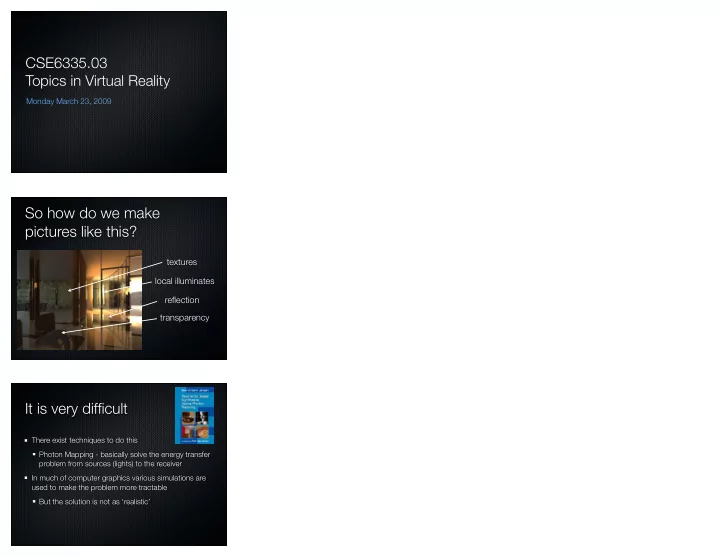

CSE6335.03 Topics in Virtual Reality Monday March 23, 2009 So how do we make pictures like this? textures local illuminates reflection transparency It is very difficult There exist techniques to do this Photon Mapping - basically solve the energy transfer problem from sources (lights) to the receiver In much of computer graphics various simulations are used to make the problem more tractable But the solution is not as ‘realistic’
Mathematic requirements Need to model the camera Need to model objects Need to model how light interacts with objects Modeling the camera Man drawing a lute, Albrecht Durer, 1525 Perspective Model Project objects in a scene onto a plane given a camera centre ‘C’, and an image plane R a distance f from C X/Z=x/f and Y/Z=y/f
Modelling Simplest model is to assume that objects are represented by collections of polygons (often triangles). Triangles are defined by 3 vertices, are planar. Can be coloured in different ways (deal with that later). Need to have ways of transforming objects (collections of triangles, defined by vertices) Transformations on 2d points If we write points as column vectors p=[x y] T then can implement many geometric transformations as matrix multiplications on p Rotate p by theta around Scale p by (a,b) origin Transformations on 2d points But this does not work for translations You cannot express p’=[a b] T +[x y] T using p’=Mp
Homogeneous Coordinates Represent coordinates in 3 dimensions rather than 2 Composing transformations Translate p by [3 0], then rotate by 45 degrees then translate by [-3 0] Note that this entire process can be represented by a single matrix (the Transformation Matrix) In 3D Homogeneos coordinates a 4x1 vectors Rx(a), Ry(a), Rz(a), T(dx,dy,dz), S(sx,sy,sz) Remember rotations do not commute.
Lights and Objects Phong Shading Model N - surface normal L - lighting vector R - light reflectance vector V- viewer vector Lights and Objects Now we have to shade polygons (here triangles) Flat shading (colour entire polygon the same colour) Goraud shading (compute colour at each vertex, interpolate over polygon) Phong shading (compute normal at each vertex, interpolate over polygon) Hidden Surface Removal Backface culling (don’t paint surface pointing away from the camera) Painters algorithm (paint back surfaces first) z-buffer algorithm (keep r,g,b,d) only paint with d<d current and update d current There are many other algorithms too
So an example This has - lights - textures - shading model - hidden surfaces Observe though No shadows, caustics, transparencies, reflections, .... Need to Define objects Define lights Define surface properties VE We will use VE as the programming environment There are others (e.g., Cave Juggler) VE is a library that supports the development on a wide range of hardware infrastructures. Extracts many of the details associated with dealing with displays and input devices. It is NOT a rendering environment
Basic Concepts VE programs may run in a distribute mode (over many computers). Code must be written with this in mind. If not, it will appear to run well on one machine and die horribly when run elsewhere. Lets walk through an example This is the ‘driver’ example found in the wingman directory of the course web page. It provides a very simple display and talks to the wingman steering wheel device (usb) Key elements of the code This builds towards an opengl renderer. So it has to do all the things that an opengl program does (like include the necessary headers).
Initialize ve Override some default options. Here to require a depth buffer. Define a function that will initialize the graphical state for the display
This just does OpenGL magic to define how rendering will take place. Define a function that will redraw a display when needed OpenGL program that draws a red and white checkerboard on the y=0 plane
Tell ve to automatically synchronize state information across machines NB: globalState cannot be large Only information in here will be synchronized across the displays (and master). Set on master, copied to displays. do some things only on the master node
define how certain input events will be handled by your code ve input model Input devices fall into one of a small number of classes switch, valuator, ... When a specific input device has input, the appropriate callback is executed on the master
Input devices Defined by the devices file No file --- no input Can do some very complex things. Or not... ‘wingman’ is a joystick Rename default axis names to something more readable we wish to be awoken periodically to do things
Remember to call vePostRedisplay() if you want displays redrawn... Executed on master initialize the texture manager pass control to ve
Building the application make -f Makefile.linux Running the application Must set two environment variables VEROOT ~ivy/ve-2.2 LD_LIBRARY_PATH ~ivy/ve-2.2/lib csh setenv VEROOT ~ivy/ve-2.2 So on my mac... Makefile.osx VEROOT ~/Documents/Hacking/ve DYLD_LIBRARY_PATH ~/Documents/Hacking/ve/lib
Simulating a wingman... Map certain keys into ‘wingman’ events Playing with a GamePad Docs in /cs/home/ivy/ve Now vesample... x/X/y/Y/z/Z - translate p/P/q/Q/r/R - rotate s/S - scale
Recommend
More recommend